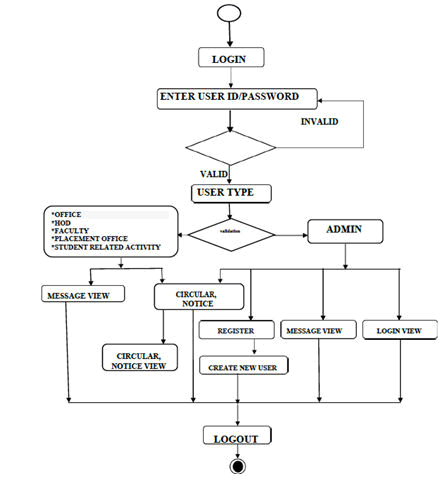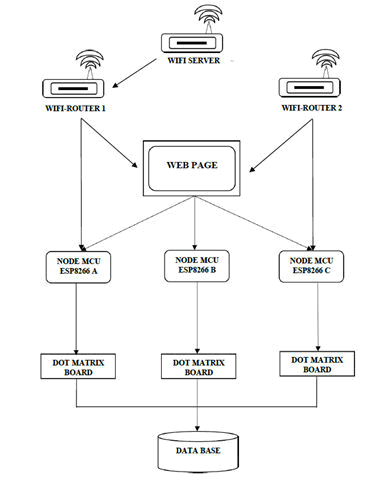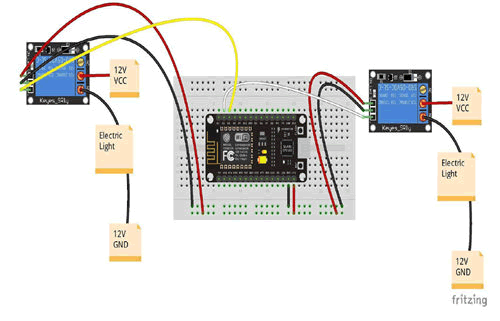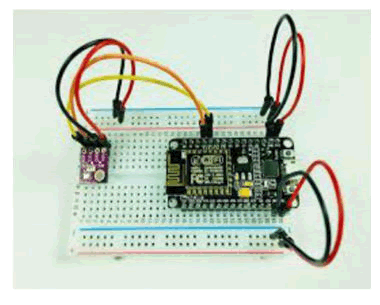Review Article, J Nucl Ene Sci Power Generat Technol Vol: 11 Issue: 2
Instant Wireless Message Notification
Prasanna Mishra*, Surya J, Bhama S
Department of Computer Applications, PSG College of Technology, Coimbatore,India
*Corresponding Author: Prasanna Mishra
Department of Computer Applications, PSG College of Technology, Coimbatore, India
E-mail: prasannamishra234@gmail.com
Received date: 29 January, 2022, Manuscript No. JNPGT-22-45904;
Editor assigned date: 31 January, 2022, PreQC No. JNPGT-22-45904(PQ);
Reviewed date: 14 February, 2022, QC No. JNPGT-22-45904;
Revised date: 21 February, 2022, Manuscript No. JNPGT-22-45904(R);
Published date: 24 February, 2022, DOI: 10.4172/2325-9809.1000258
Citation: Prasanna Mishra, Surya J, Bhama S (2021) Instant Wireless Message Notification. J Nucl Ene Sci Power Generat Technol 11:2.
Abstract
The most popular medium of message conveyance in any organization, institution and public utility place is the notice board.But sticking and changing the notices every day is a complex process. Especially, in the academic domain, there are many stakeholders involved and students need to be noticed with circulars regarding many activities. This paper focuses on the creation of a web based connectionless digital notice board for an educational institution, which displays notices as and when required on a screen. Only authorized persons can access the web page and also send messages to the users regarding payment of fees, publishing results, and notification of upcoming events in the college campus, pending library dues, payments for hostel, registrations for workshops or conferences, any other warnings and reminders, etc. This paper proposes an Internet of Things (IoT) based application, to develop a digitized notice board that can be used by any organization. It is mainly about digital boards with node MCU ESP8266, which includes a web application. The circulars or instructions are displayed on more than one dot matrix boards through wireless communication. In this process, a large amount of time is saved and old messages are also archived for future reference.
Keywords: Digital notice board, IoT, Circular, Wireless, Lolin node MCU ESP8266
Introduction
In educational institutions, notice boards are used for conveying information to the users. This is a traditional system of message notification which requires more physical effort for its design and communication [1]. This leads to the need for digitization of the notice board system, with replacement using a faster and efficient digital notice board system that goes paperless and also reduces the maintenance cost. Digital notice board is one of the ways of displaying notices on screen.
The message to be communicated is typed and sent for displaying. The display screen and the system are connected to each other with the help of a node [2]. More than one notice can be made visible on the screen as the notices scroll across the screen.
Only authorized persons can access this site using the basic credentials. The login page has different options like register, circular, message view, login view, logout. Only the admin can create a new user id with the help of the register option.
The proposed system is developed with Arduino IDE coding for node MCU hardware components. Web pages are developed with the help of PHP as front-end and MySQL database as back-end. The system also has the interfacing node MCU ESP8266 with dot matrix board to display scrolling text messages from web user interface. MCU ESP8266 library is used for execution, with some improvements in web user interface HTML code.
Literature Review
The primary medium of communication in any institution or organization is the notice board. But, the traditional notice board does not suit itself to cases where notices are to be displayed dynamically. The initiator in incorporating advanced technologies for notice board communication is the GSM (Global System for Mobile Communication), implemented at Bell Laboratories in 1970. It is a kind of mobile network that is prominently digitized and is popularly used by most of the mobile phone users.
Wireless electronic display boards were used for message transmission along with the application of GSM technology. The field of advertisements has also been equipped with usage of digital technologies. The attraction of end users with catchy scrolling messages has led to the use of LED displays in notice boards [3]. The use of this type of scrolling LED display reduces the efforts and time involved in notice board display.
The combination of GSM technology with LED based scrolling message display is a model for notice boards for communication within any networked area.
Also, in today’s world of smartness, message communication and display play a very vital role. One of the literature works provides message display with smart phone [4]. Message display is made on LCD screen, using different technologies such as, GSM and Bluetooth.
Most public places need emergency and real-time notices. This paper focuses on the development of a web based application for wireless digital notice boards that can be used by any organization.
Task flow and technologies
The tasks involved in the instant message notification system are depicted in the form of a flow diagram in (Figure 1).

Figure 1: Task flow of instant notification.
As seen, any user has to register with the system and use those credentials for logging in. The admin has complete control over all activities such as new user account creation, message creation and display. Other users can just view the messages or circulars or notifications.
The proposed system generates circulars or instructions which are displayed on more than one dot matrix boards. The system allows only registered persons who can login into the web-page for sending message to node MCU ESP8266. In the proposed system, a well-developed web-page is designed to send circular and other information to multiple classes in an institution at the same time by selecting the appropriate options. Multiple display boards can be connected and hence huge time is saved. The admin can add users or remove users instantly, and have database connectivity for viewing messages and other user details.
The development of the proposed system involved the use of both hardware and software components which are shown in (Figure 2).

Figure 2: Software and hardware connectivity.
The system provides a wireless, web based application with dot matrix board displays connected to NodeMCU components.
The technologies used in the development of the instant message notification web application are discussed below.
Lolin NODE MCU ESP8266
It is a single chip micro-controller which receives messages from web pages, stores them in buffer storage and then forwards it to a dot matrix board for display. In order to send messages to several classes, the proposed system has connected multiple Node MCU.
HTML
Hypertext Markup Language (HTML) is used as the standard markup language in the creation of web pages. It contains elements called HTML tags, which usually occur in pairs. Web browsers can read the HTML file, interpret the content and compose it into a web page. It is the elementary building block of all websites. Even other media such as images, audio and video can also be embedded to create interactive forms.
CSS
In order to describe the look and format of web pages written in HTML and XHTML, Cascading Style Sheets (CSS) are used. CSS provides an option for splitting the content and presentation parts of a document, which improves the accessibility of the content, leading to good flexibility and also reducing the complexity in the web page structure.
PHP
It is basically a server-side scripting language, especially meant for the developers in the creation of dynamic web pages. It allows code to be embedded with HTML or in combination with any web framework. Normally, an interpreter is used to process the PHP code. The link between PHP and web server is supported in two basic ways – one, as a native web server module, and the other using a CGI executable. For PHP command-line scripting, a user interface called the Command-Line Interface (CLI) is required.
MYSQL
It is the major component of the open source LAMP (Linux, Apache, MySQl, PHP) web development software platform. It provides a database system used by many websites on the Internet. It includes tools for command line, desktop software and other web applications in order to create and manage the database.
Instant message notification application design
The various modules in the design of the web application for message notification are discussed below.
Admin Login
The admin has a specific id and password for login into the website to pass notice and circular to the dot matrix display board. The admin login page includes different options like register, circular, message view, login view and logout. Admin can create a new user id with the help of the ‘register’ option. The ‘circular’ option shows selections of circular category, year with class option and the message box with send button. The login page is designed to be compatible with both mobile and computer.
Registration
In this application, only the admin can create a new users by providing details in required fields like user types like (admin, HoD, faculty, office, placement office, student related activity), user name, phone number, mail-id, address, pin code, password and retype-password. These details are stored in the database. Admin can create more than one user under the same user type with different user details.
Circular
This option can be used to send information and notice to the dot matrix board. It is a common option for all users. It shows the circular category (general, academic, daily update, event, placement, flash news), academic year (I, II, III or ALL), sections like A, B, C, ALL) and message box. The admin selects a particular circular category, academic year, section and types the required information and notice in the message box, and then sends it to the display dot matrix board. Only authenticated users are able to add notice.
Message view
Admin can view all the messages, along with details like id, user name, phone number, user type, category, batch, section, message, date and time and action. Admin can also search a message, and admin can delete old and unwanted messages from the database.
Login view
This option is only for the admin. It shows the count of users who have the permission to access this website.
User login
Users also have a specific id and password for login into the website to pass notice and circular to the dot matrix board. The users’ login page shows login user name and user type with different options like circular, message view, logout.
The circular option information shows the circular category, academic year, section and message box. If the user selects a particular circular category, academic year, section and types the required information and notice in the message box, they are sent to the display board. Only authenticated users are able to add notice.
In users’ message view option, they can see only their sent message along with the details entered. Users do not have the delete option like the admin. They can only view and update messages. The ‘logout’ option is common for all users.
Discussion
Prototype implementation
The system is tested with the classroom message notification. Before powering up the dot matrix board and node MCU, the wiring is checked carefully [5]. The test program can display a scrolling message, designed for an 8 × 8 display. Power supply for the dot matrix board through node MCU pins as shown in (Figure 3).

Figure 3: Pins connection.
The hardware testing is done with Arduino IDE and ESP8266 library. Board designs can be modelled using NodeMCUz. The Node MCU 12e model is selected in the board manager. First, the coding is dumped to the node MCU [6]. After that, the connection with the correct Wi-Fi signal is checked. The range of signal strength is within 100 mtrs per node MCU. The performance of the digital notice board is tested with the hardware connections shown in (Figure 4).

Figure 4: Hardware connections.
Software testing is used to test the web application. First, the internet connection is checked with the correct Wi-Fi signal. After that, the web address is typed in the web browser which will redirect to the digital notice web-page [7]. Here, the desired message to be notified can be typed and then forwarded with single button click. The message will be passed to the appropriate node MCU by the Wi-Fi signal, and the received messages in node MCU are passed to the dot matrix board by connected pins. Finally, it will be displayed on a dot matrix board.
Conclusion
The day-to-day evolution of trending technologies has triggered the digitization of activities. This has its impact on almost all domains. The academic notices are moving towards digital display boards. The system explores the notification systems and models an instant message notification through node MCU esp8266 using a dot matrix board display. The system is tested successfully and reduces the manual work of maintenance of the notice or circular information issues. The technology world is not static. Hence, to keep up with the technological improvements, the system needs refinements. As a future enhancement, development of wireless message notification with audio output is planned.
References
- Foram K, Anubbhav M, Pritish M (2013) Display message on notice board using GSM. Adv Electr Elect Eng. 3: 827-832.
- Jagan Mohan R, G Venkareshwarlu (2013) Wireless electronic display board using GSM technology. Int J Electr Electr Data Commun. 1: 50-54.
- Anuradha M, Vaishali N, Deepika S (2014) Scrolling LED display using wireless transmission. Int J Eng Dev Res. 2: 475-478.
- Savan Shah (2015) Message displayed on LCD screen using gsm and bluetooth technology. Int J Adv Res Comp Commun Eng. 4: 345-347.
- Darshika M, Mamta T, Rageeni W, Vivek G (2018) Review on electronic notice board. Int Res J Eng Technol (IRJET). 5: 592-594.
- Dheeraj V (2020) Smart notice board using NodeMCU ESP8266. Int Res J Eng Technol (IRJET) 7.
- Asmita K, Mugdha R, Vikas G, Pranjal S (2020) Real time digital display notice board on multiple screens. Int J Eng Res Technol (IJERT). 9:2 25-229.
 Spanish
Spanish  Chinese
Chinese  Russian
Russian  German
German  French
French  Japanese
Japanese  Portuguese
Portuguese  Hindi
Hindi 

